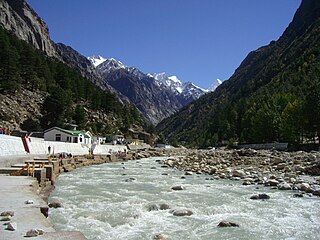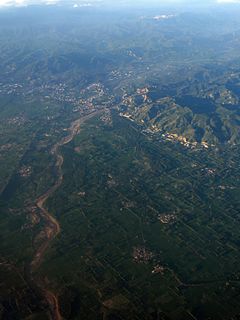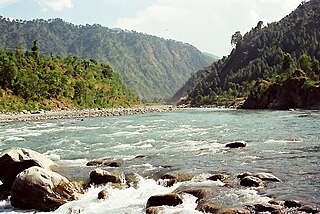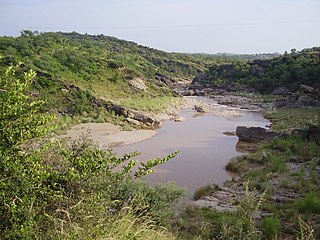 W
WThe Beas River is a river in north India. The river rises in the Himalayas in central Himachal Pradesh, India, and flows for some 470 kilometres (290 mi) to the Sutlej River in the Indian state of Punjab. Its total length is 470 kilometres (290 mi) and its drainage basin is 20,303 square kilometres (7,839 sq mi) large.
 W
WThe Bhāgīrathī (Pron:/ˌbʌgɪˈɹɑːθɪ/) is a turbulent Himalayan river in the Indian state of Uttarakhand, and one of the two headstreams of the Ganges, the major river of Northern India and considered holy in Hinduism. In Hindu faith and culture, the Bhagirathi is considered the source stream of the Ganges. However, in hydrology, the other headstream, Alaknanda, is considered the source stream on account of its great length and discharge.
 W
WThe Chautang, originating in Siwalik Hills, is a tributary of Sarsuti river which in turn is tributary of Ghaggar river in of Haryana state of India.
 W
WThe Chenab River is a major river that flows in India and Pakistan, and is one of the 5 major rivers of the Punjab region. It rises in the upper Himalayas in the Lahaul and Spiti district of Himachal Pradesh state, India, and flows through the Jammu region of Jammu and Kashmir into the plains of Punjab, Pakistan, before flowing into the Indus River near the city of Uch Sharif. The waters of the Chenab were allocated to Pakistan under the terms of the Indus Waters Treaty.
 W
WThe Tangri River, also called the Dangri River, which originates in the Shivalik Hills, is a tributary of the Ghaggar River in the Haryana state of India.
 W
WThe Drishadvati river is a river hypothesized by Indologists to identify the route of the Vedic river Saraswati and the state of Brahmavarta. According to Manusmriti, the Brahmavarta, where the Rishis composed the Vedas and other Sanskrit texts of the Vedic religion, was at the confluence of the Saraswati and Drishadwati rivers during the Vedic period.
 W
WIn Hinduism, the river Ganga is considered sacred and is personified as the goddess Gaṅgā. She is worshiped by Hindus and Buddhists who believe that bathing in the river causes the remission of sins and facilitates Moksha, and that the water of the Ganges is considered very pure. Pilgrims immerse the ashes of their kin in the river Ganga, which is considered by them to bring the spirits closer to moksha. She is known by many other names including Bhagirathi, Jahnavi, Nikita, Jaahnukanya, Sapteshwari, Sureshwari, Bhagvati, Urvijaya, Chitraani, Tridhara, Bhaagirathi, Shubhra, Vaishnavi, Vishnupadi, Bhagvatpadi, Tripathaga, Payoshnika, Mahabhadra, Mandaakini, Meghna, Meghal, Gangika, Gange, Gangeshwari and Alaknanda.
 W
WThe Ganges or Ganga is a transboundary river of Asia which flows through India and Bangladesh. The 2,704 km (1,680 mi) river originates from the Gangotri Glacier of western Himalayas in the Indian state of Uttarakhand, and flows south and east through the Gangetic Plain of India and Bangladesh, eventually emptying into the Bay of Bengal.
 W
WThe Ghaggar-Hakra River is an intermittent river in India and Pakistan that flows only during the monsoon season. The river is known as Ghaggar before the Ottu barrage and as the Hakra downstream of the barrage. The Hakra river is hydraulically connected to the Nara River provided it has adequate flow to maintain surface flow. After the construction of the Otu Barrage, the downstream Hakra river dried up fully but subsurface flow is maintained to the Nara river which becomes later the delta channel of the Indus River before joining the sea via Kori Creek in Gujarat state.
 W
WThe Kaushalya river, a tributary of Ghaggar river, is a river in Panchkula district of Haryana state of India.
 W
WThe Markanda river in Himachal Pradesh and Haryana states of India is a tributary of Ghaggar river, flowing through Sirmaur District, Ambala district and Shahabad Markanda town in Kurukshetra district. The Markanda river's ancient name was Aruna.
 W
WGomal River is a 400-kilometre-long (250 mi) river in Afghanistan and Pakistan.
 W
WHaro is the name of a river that flows through Khyber Pakhtunkhwa and parts of Punjab. Its main valley is in Abbottabad District in the Hazara Division of Khyber Pakhtunkhwa province, northern Pakistan. The famous Khanpur Dam has been built on this river at Khanpur in the Haripur District of Hazara Division to provide drinking water to the twin cities i.e. Islamabad and Rawalpindi. The decrease in inflows of Khanpur dam from Haro River results in water shortage in the twin cities during summer season.
 W
WThe Indus River is one of the main rivers of the Indo-Gangetic Plain in the Indian subcontinent. It flows through China, India, and Pakistan. Originating in the Tibetan Plateau in the vicinity of Lake Manasarovar, the river runs a course through the Ladakh region of India towards Gilgit-Baltistan, and then flows in a southerly direction along the entire length of Pakistan to merge into the Arabian Sea near the port city of Karachi in Sindh. The Indus is the longest river of Pakistan.
 W
WThe Jhelum River is a river in northern India and eastern Pakistan. It is the westernmost of the five rivers of the Punjab region, and passes through the Kashmir Valley. It is a tributary of the Chenab River and has a total length of about 725 kilometres (450 mi).
 W
WThe Kabul River, the classical Cophen, is a 700-kilometre-long (430 mi) river that emerges in Maidan Wardak Province in the Sanglakh Range of the Hindu Kush mountains in Afghanistan, and is separated from the watershed of the Helmand River by the Unai Pass. The Kabul River empties into the Indus River near Attock, Pakistan. It is the main river in eastern Afghanistan and the Khyber Pakhtunkhwa province of Pakistan.
 W
WThe Ravi River is a transboundary river crossing northwestern India and eastern Pakistan. It is one of six rivers of the Indus System in Punjab region.
 W
WThe Sahibi river, also called the Sabi River, is an ephemeral, rain-fed river flowing through Rajasthan, Haryana and Delhi states in India. It drains into Yamuna in Delhi, where its channeled course is also called the Najafgarh drain, which also serves as Najafgarh drain bird sanctuary. Sahibi is a seasonal river which is 300 km long and flows from Aravalli hills in Rajasthan to Haryana, of which 100 km is in Haryana.
 W
WThe Sarasvati River is one of the rivers mentioned in the Rig Veda and later Vedic and post-Vedic texts. It plays an important role in the Vedic religion, appearing in all but the fourth book of the Rigveda.
 W
WThe Sarsuti river, originating in Siwalik Hills and flowing through the palaeochannel of Yamuna, is a tributary of Ghaggar river in of Haryana state of India. Its course is dotted with archaeological and religious sites dating back to post-Harrapan Mahabharata sites from Vedic period, such as Kapal Mochan, Kurukshetra, Thanesar, Brahma Sarovar, Jyotisar, Bhor Saidan and Pehowa.
 W
WThe Soan River, also referred to as the Swan, Sawan, or Sohan, is a river in Punjab, Pakistan.
 W
WThe Sutlej River is the longest of the five rivers that flow through the historic crossroads region of Punjab in northern India and Pakistan. The Sutlej River is also known as Satadree. It is the easternmost tributary of the Indus River.The bhakra dam is built around the river Sutlej to provide irrigation and other facilities to the nearby areas.
 W
WThe Swat River is a perennial river in the northern region of Khyber-Pakhtunkhwa Province, Pakistan. The river commences in the Kalam Valley of Swat Kohistan with the confluence of two main tributaries Ushu and Utrar and runs downstream in a narrow gorge up to Baghdheri.
 W
WThe Yamuna is the second-largest tributary river of the Ganga and the longest tributary in India. Originating from the Yamunotri Glacier at a height of 6,387 metres (20,955 ft) on the southwestern slopes of Banderpooch peaks of the Lower Himalaya in Uttarakhand, it travels a total length of 1,376 kilometres (855 mi) and has a drainage system of 366,223 square kilometres (141,399 sq mi), 40.2% of the entire Ganga Basin. It merges with the Ganga at Triveni Sangam, Prayagraj, which is a site of the Kumbh Mela, a Hindu festival held every 12 years.